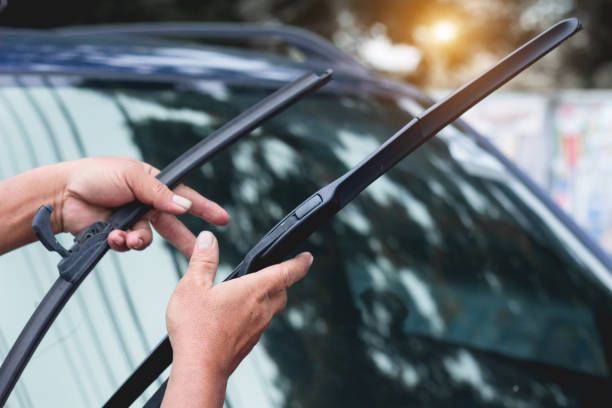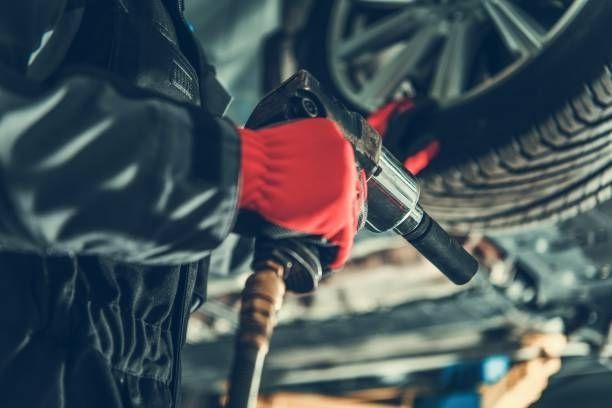9 Step Checklist: Preparing Your Car For Winter
Check your coolant
If you’re using traditional coolant, you’ll need to make sure you have a 50/50 mixture of water and antifreeze to prevent the fluid from freezing in your radiator. Check the ratio using a testing kit or schedule an appointment with AutoMedics to fill the right mixture up to the maximum line.
Check Your Battery
The chemical reactions required to generate power in a car battery slowdown in extremely cold temperatures, and your car requires more current from the battery to start the engine. To avoid a car that won’t start on a cold morning, run a battery load test to see if your battery has enough juice. Check battery cables and terminals for cracks, and make sure the fluid is filled to the top of the cap (if not, fill with distilled water).
Fill Your Wiper Fluid
Winter driving is hard enough—reduced visibility makes it much worse. Having enough wiper fluid is crucial to keeping your windshield free of ice, snow, salt, and mud. Make sure you use freeze-resistant wiper fluid.
Replace Your Wiper Blades
Keeping your windshield free of winter precipitation is a tough job—make sure your wiper blades are up to the task. Most blades are only good for six months to a year, so chances are you need new ones. While you’re at it, you might want to consider choosing a heavy-duty wiper blade specifically designed for winter conditions.
Fill Your Wiper Fluid
Winter driving is hard enough—reduced visibility makes it much worse. Having enough wiper fluid is crucial to keeping your windshield free of ice, snow, salt, and mud. Make sure you use freeze-resistant wiper fluid.
Inspect Your Tires
Tires with worn treads are a serious hazard in winter conditions. If you live in an area that experiences a lot of snowfall, consider getting snow tires, which are made of softer rubber that remains flexible in colder temperatures, and have treads specially designed to keep their grip in snow and ice.
If you have all-season tires, check to make sure the tread is at least 5/32” for the best winter traction. If your tread is less than 2/32”, your tires will offer virtually zero traction in snow and be prone to hydroplaning in rain and should be replaced regardless of the time of year.
Here’s an easy way to test your tread: insert a penny into a tread groove with Lincoln’s head pointing down. If no part of Lincoln’s head is covered, your tires need to be replaced. Flip the penny over and do the same test with the Lincoln Memorial facing down. If any part of the building is covered, your tires are ready to tackle winter weather.
Check Your Tire Pressure
No matter whether your tires are new or older, make sure they’re properly inflated for winter conditions. Cold weather causes air pressure in your tires to drop at a rate of approximately 1 PSI per 10 degrees, so check your tire pressure regularly to make sure it stays at the level recommended by the manufacturer. The usual recommended tire pressure is 30-35 PSI but check your owner’s manual for the exact number. And don’t forget to check your spare!
Change Your Oil
Your engine needs lubrication to run, but cold weather thickens oil and reduces its ability to circulate through the engine, so make sure you have fresh oil to keep things running smoothly. Some experts recommend using a thinner oil during the winter months—consult your owner’s manual or mechanic to see if that approach is right for your car.
Check Your Belts and Hoses
Cold temperatures can weaken the belts and hoses that keep your engine running. Prepare for winter by checking all belts and hoses for cracks or signs of wear and tear and replace them if needed.
Put together an emergency kit to carry in your car
Despite excellent planning, winter weather can still take you by surprise and put you in a dangerous situation. Be ready for the unexpected by equipping your car with emergency supplies including blankets, flares, a jack, a first-aid kit, flashlight, shovel, food, and kitty litter or sand for traction if you get stuck.
Customers Reviews

★★★★★
My car had engine issues and was chugging and losing power. I called around to lots of different places and everyone was two weeks out. Called this place and they said that if I could limp my car there right now they could squeeze me in, and take a look at my car. They looked at it, and were able to get it repaired and ready for pick up the next day in time for me to go to work. They also gave me an accurate quote so I wasn't surprised with the bill. All in all, I highly recommend if you have car troubles.
-Walker V.
2023
Button
★★★★★
This place is fair and honest!
-Matt W.
2023
Button
★★★★★
Honest and Friendly service. They inspected for an oil leak, found it was a valve cover gasket and got me an appointment within a week. Great interaction and a quick repair. A couple years ago I called around for a wheel bearing replacement and they were the cheapest. Multiple friends recommended Automedics and I now pass on this recommendation. They work on foreign and domestic vehicles. Give them a ring.
-Drew G.
2023
Button
★★★★★
Best mechanic I’ve gone to, always have gotten my car in and out extremely quickly!
-Shelbie V.
2023
Button
★★★★★
FANTASTIC A++ experience! Mike was a gem to work with and had my car's tire fixed in 30 mins.. Super kind and affordable! Highly recommended!
-Dan B.
2023
Button
★★★★★
Highly recommend Mike and his crew at Automedics
Absolute top notch customer service and 100% trust worthy!!
-Pam M
2022
Button
★★★★★
To Mike and all the guys at Auto Medics, I just wanted to say THANK YOU, for being honest mechanics. I brought a car in to be inspected as a potential purchase. While Mike could have simply said all the repairs were necessary and the car would ultimately be a good purchase so he could benefit with the repair work, he was straight with me.... He told me that for the cost of the purchase and the subsequent repairs, maybe it'd be better if I buy a better, newer car and avoid the hassle of future repairs. Thanks, Mike! Your honesty has won me over--I plan to be back for more business! It's a relief to feel a sense of trust in my auto mechanic! Thanks!
-Mike B.
2022
Button
★★★★★
While driving through Duluth on our way to a speaking engagement, I just about lost a wheel due to loose lug nuts from a recent tire rotation. I called over a dozen shops, including Autmedics in Duluth MN (all of which were were fully booked out for at least several days). With our 4 kids in tow, my wife and I needed help. Mike at Automedics had compassion on us and worked with our vehicle himself to help us out. That level of compassion in the midst of a backlog of work and phone calls is rare. So to Mike and Crew, sincerely, thank you.
-Jeffrey R.
2019
Button
★★★★★
Best place to take your vehicle, to get fixed
-Mike M.
2021
Button
★★★★★
Mike Archer and the crew have handled many repairs and general maintenance for our family vehicles for years and have never disappointed us - great experience, totally honest, great expertise and good value - hard workers and friendly service - Would gladly recommend these guys to anyone!
-Paul L.
2021
Button
★★★★★
Great staff, great service and professional repairs. I've known the Archer family over 50 years. No regrets! Thanks so much. The AC is working great!
-Scott R.
2021
Button
★★★★★
Came into town and ended up with a large bolt in my tire. The employees at AutoMedics were all very polite and friendly and worked me in within a couple mins. I would highly recommend this shop!
-Heidi S.
2021
Button
★★★★★
I go to them with any of my car issues and if they can't help they always recommend someone else awesome in town that can. 10/10 customer service and knowledge.
-Abigail S.
2021
Button
★★★★★
I've taken my vehicles here four times now since I moved to Duluth and have always had a great experience. They are very friendly, honest, and even go out of their way to look out for their customers.
-Brandon C.
2021
Button
★★★★★
Good service treated fairly would recommend
-Tom J.
2021
Button
★★★★★
Good group of guys who got the job done without any issues. Good price, low wait. Found my new mechanics.
-Quinnmaherr
2021
Button
★★★★★
Excellent and timely service every time we use them. Highly recommended!
-Jenc00051
2021
Button
★★★★★
After a few recent visits to see Mike with multiple issues, I will be a loyal customer. Pricing is fair and honest and I will definitely return for any future repair needs. I had a problem that was not clear, and Mike was very honest and did not do any unneeded repairs and spent a lot of time trying to figure out what the problem was. The pricing and work is made clear before being done and communication is great.
-Katie L.
2021
Button
★★★★★
I called AutoMedics last minute during the holiday season, they got me in for an oil change and tire rotation before my travels! They are friendly, knowledgeable, do a great job and put a better oil in my car because they knew it would be helpful, all still while being more inexpensive than other places. I highly recommend them!
-Phelan R.
2021
Button
★★★★★
Wonderful speedy service with a smile
-Winona N.
2021
Button
★★★★★
Wonderful quick service with a smile
-Winona C.
2021
Button
★★★★★
These guys are the best in town! I’ve been taking my vehicle to them for years. They are honest, friendly, and have gone out of their way to help me out many times. They also don’t talk down to me like other mechanics I’ve encountered. I’ve felt 100% satisfied with every interaction and they’ll continue to be my go-to shop!
-Ellen V.
2021
Button
★★★★★
Mike and the crew did a great job at a very reasonable price. Highly recommend.
-Joseph M.
2021
Button
★★★★★
I was driving up from the cities on 4th of July weekend when the AC went out in my van. Not knowing who to call, I started calling shops not too far from my hotel. Another shop that didn’t have time recommended AutoMedics. What a wonderful experience!!! They were gracious, kind, and so willing to help even though they all wanted to enjoy their holiday weekend!! The diagnosis was spot on, the price was absolutely reasonable and fair, and the service was professional and quick. I was back on the road in 90 minutes! Thank you so much for taking good care of me while I was away from home! I highly recommend this shop!!
-Karen A.
2020
Button
★★★★★
Mikey an JJ are the best
-Andrew L.
2020
Button
Browse our website
Contact Information
Our Location




